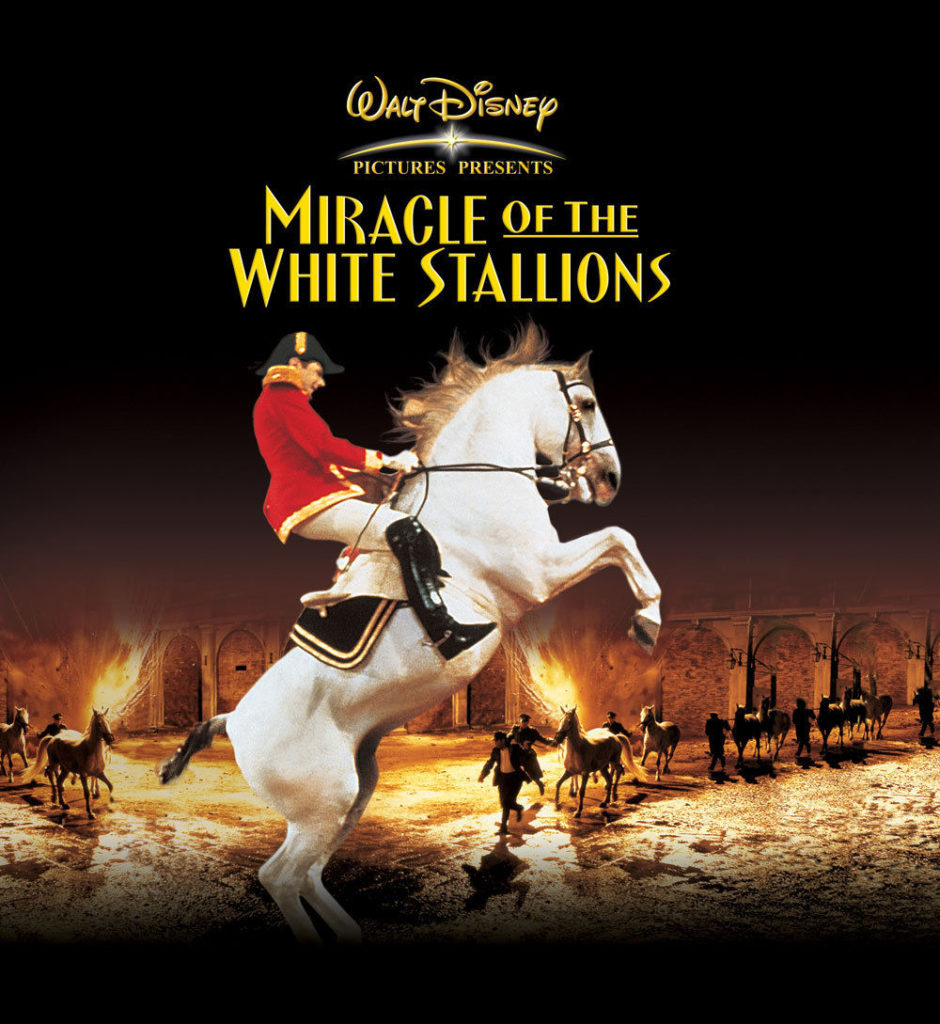Recently Walt Disney’s Miracle of the White Stallions celebrated its 53rd anniversary. Distributed by Buena Vista Distribution in both the US and foreign markets, this live-action film was by no means a high-grossing blockbuster success. In fact, this 93-minute film only made about $2.5 million. Regardless of its financial success, Miracle of the White Stallions is a unique film in many ways and a true gem.
Based on the autobiographical novel The Dancing White Horses of Vienna by Alois Podhajsky (retired head of the Spanish Riding School), Miracle of the White Stallions tells the true story of the evacuation of the Lipizzaner horses from the Spanish Riding School during World War II. In the film (and in real life) Podhajsky sought the help of the US Army and General George Patton in moving the horses across the country before the Nazis could attack and destroy Vienna, Austria. As a fellow hippophile (a lover of horses) it is easy to see why Walt Disney chose this material for a live action film.
Large parts of this film were filmed on location at the Spanish Riding School and other areas of Vienna. The actual riding and performance for General Patton was performed be the Spanish Riding School and was choreographed by Alois Podhajsky. It is an amazing thing to watch and just another reason that Miracle of the White Stallions is so special. Walt Disney was very proud of the finished product and it was edited into two Wonderful World of Color TV episodes; “Walt Disney’s Wonderful World of Color: Flight of the White Stallions: Part 1 and Part 2.”
What about the actual horses? What was so special about these stallions that military men willing risked life and career to move a stable full of horses across enemy borders? Let’s take a look at this very unique, intelligent and classical breed of horse.
- The Lipizzaner, or Lipizzan horse is synonymous with the Spanish Riding School in Vienna, Austria.
- The Spanish Riding School, built in 1735 and named after the original Spanish heritage of the Lipizzaner horses, still remains the home of the riding school. It was at this school that the traditional methods for training Lipizzaners were developed. These methods are still in use.
- The Lipizzaner horses at the Spanish Riding School demonstrate the “high school” movements of classical dressage — highly controlled stylized jumps and other movements known as “airs above grounds.”
- Initially, the methods for training at the Spanish Riding School were passed down orally. It wasn’t until 1898, almost 160 years after the opening of the school, that the first instruction guide was written.
- In general, the exercises taught to the Lipizzaners are based on drills taught to cavalry riders to prepare their horses for wartime.
- Lipizzaner stallions enter the Spanish Riding School around the age of four years old and training takes an average of six years or until the horse and rider have mastered “School Quadrille.”
- The Spanish Riding School only accepts Lipizzaner stallions. Other Lipizzaner riding schools accept both mares and stallions.
- Lipizzaner horses date back to the 16th century and were originally developed for nobility. The breed was named after the town they originated.
- The stock for the Lipizzaner comes from the cross breeding of Spanish, Barb, Arabian and the now extinct Neapolitan horse breeds. Eight stallions and 35 mares are recognized as the foundation stock for this breed. It is said that every Lipizzaner horse (even the horses of today) are able to trace their lineage back to one of the original eight stallions.
- In terms of appearance, Lipizzaner horses are normally gray in color (a process that can take about seven years) and stand about 14 hands (a relatively normal height for a horse). They are a sturdy, well-defined, muscular breed with surprisingly small hooves. It is said that Lipizzaner horses mature slowly but can live well into their late twenties.
- It is tradition at the Spanish Riding School for there to be stabled a least one bay Lipizzaner stallion.
- Currently there are around 11,000 Lipizzaner horses registered with The Lipizzan International Federation or LIF. The LIF is the governing organization that fosters adherence to traditional breeding objectives, ensures horses are registered within a database and have pure blood lines. The LIF also creates education programs to promote the breed.

